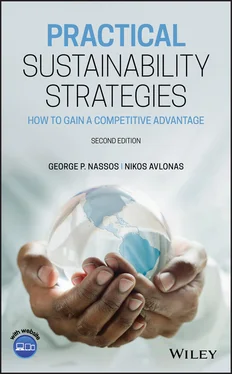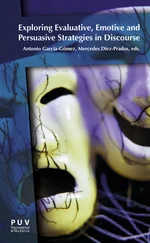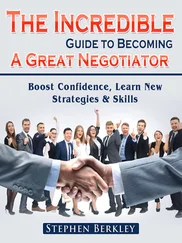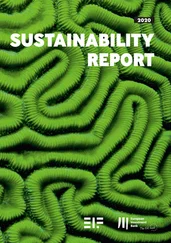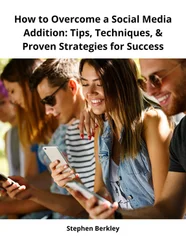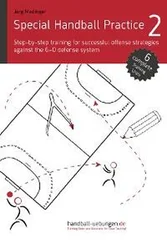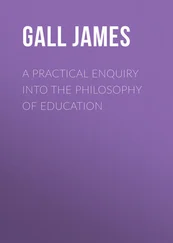I became so interested in sustainable strategies that I researched the topic on a continuous basis and added new strategies and case studies to the course almost every year. Since about 80% of the students were working professionals—part-time students—the final exam for the course was actually a project. Each student was challenged to apply one of the sustainability strategies to their workplace and show how it would enhance the company, a subsidiary or a strategic business unit (SBU) in terms of environmental integrity, social equity, and economic viability. If it didn't, I didn't want to hear about it. The full-time students that were not working for a company had the option to select a publicly held company or create a new one based on the sustainability strategy.
In addition to researching for new strategies, I was also interested in books about sustainability. Over the past 10 years, I did not come across any book that dealt with the various sustainability strategies I was teaching. I am convinced that sustainability should not be a discipline in a business school like marketing, accounting, finance, or organizational behavior, but rather should be imbedded in all the appropriate courses. All graduates of a business school should have an understanding of the sustainability concept and its benefits. This book was written to enhance business programs at any or all business schools. It can also be used as the basis for a course on sustainability or as a reference to cover the topic in one or two modules of any other business course.
This does not mean that the book has been written only for business schools. Small- and medium-sized companies as well as large corporations will certainly benefit from the contents of this book. In addition, government agencies and non-governmental organizations (NGOs) will also benefit by adopting selective strategies. Just as I am convinced that sustainability should not be a discipline in a business school, it should not be the responsibility of an individual or department in a company or organization. Sustainability should be imbedded in the culture of the organization so everyone can work together to achieve their goal of operating as a truly sustainable company.
A number of years ago, I had the pleasure of meeting Nikos Avlonas, CEO and Founder of the Center for Sustainability and Excellence, an organization that trains and consults in the sustainability field. His expertise is in the measurement of sustainability metrics that are used to determine how well the organization is performing and in the reporting of its activities. Consequently, it made sense to join forces and write a book about the strategies, measurements, reporting, and communicating.
Although I retired from IIT—Stuart School of Business in 2011, I joined the Driehaus College of Business at DePaul University in 2017 as Director of the MS in Sustainability Management program. So I am continuing to do what I love best in training more disciples in the field of environmental and social sustainability.
George P. Nassos
Glenview, IL, USA
November 2019
As you set out for Ithaka
hope your road is a long one,
full of adventure, full of discovery .
My journey to sustainability was anything but linear. It started off with an interest, and then a job in Quality Assurance, passed through the challenging environment of Total Quality Management to finally reach its destination. Every step of the journey added to my knowledge of the field, offered insight, understanding, and experience.
Coming from a small town of fewer than 20,000 inhabitants and a small country of less than 12,000,000, I am still in awe of the journey so far. I founded the Centre for Sustainability and Excellence (CSE), a global Sustainability Strategic Advisory and Training organization with activities in North America, Europe, MENA, and Asia regions and had the honor of receiving recognition for my work (one of the “Top 100 Thought Leaders in Trustworthy Business Behavior” by Trust Across America in 2010, CSR Professional of the Year by PR News in 2017, and Sustainability Professional of the Year Award by the Silicon Valley Community Foundation, in 2018). I have enthusiastically passed the flame of Sustainability on to others through teaching (among others DePaul University, University of San Francisco, Athens University of Economy and Business), speaking at conferences and, in keeping with the times, through the creation of the online Sustainability Academy platform.
On this journey I have had the opportunity to meet and work with people from different walks of life, from a variety of sectors, from a multitude of countries. What lies behind the different backgrounds and interests, however, is the ardent wish to make this planet sustainable, which eventually requires that we practice what we teach and what we are taught. In this revised edition, George Nassos and I are pooling together our experience and knowledge to promote the practical side of sustainability. I hope this book will accompany students, practitioners, and enthusiasts well on their own journey.
And if you find her poor, Ithaka won't have fooled you .
Wise as you will have become, so full of experience,
you'll have understood by then what these Ithaka mean .
Nikos Avlonas
November 2019
1 1. Cavafy, CP. 1975. Ithaka, Edmund Keeley (transl.). Available at https://www.poetryfoundation.org/poems/51296/ithaka-56d22eef917ec. Accessed 2019 Sep.
ABOUT THE COMPANION WEBSITE
This book is accompanied by a companion website:

www.wiley.com/go/Nassos/PracticalSustainabilityStrategies_2e
The website includes:
1 Case Studies
2 PPT slides
PART I INTRODUCTION TO SUSTAINABILITY
CHAPTER 1 Urgency to Adopt Sustainability
It has been close to 60 years since we started reading books or articles about the environment with “Silent Spring” by Rachel Carson being one of the first important books published in 1962. Many other outstanding books have been written about the environment since then such as “The Ecology of Commerce” by Paul Hawken in 1993 and “Natural Capitalism” by Paul Hawken, Amory Lovins, and L. Hunter Lovins in 2008. The number and frequency of new books have increased as more and more people are concerned about the state of the environment.
Very few people question the decline in the state of our environment, only the degree to which it has deteriorated or the rate at which it is continuing to deteriorate. Regardless of the current status of our environment, it is important to put in perspective what has happened to our earth since its creation. Historians estimate that the earth is about 4.5 billion years old, but it is really difficult to understand exactly what this means. What does 1 billion really mean? Let's consider a situation where a 21-year-old girl is given US$1 billion as a gift, and she places the money in a noninterest bearing account. She will be able to spend US$60,000 every day of her life until she retires at the age of, say, 65 and still have US$36 million left over for retirement. This gives someone a better understanding of 1 billion really means.
So how can we put 4.5 billion years in perspective so we can understand what has happened to the earth since its creation. As suggested by David Brower [1], former Executive Director of the Sierra Club, let us compress the geologic time, from the initial formation of the earth until now, into the six days of biblical creation [2], from Monday to Saturday.
Читать дальше
